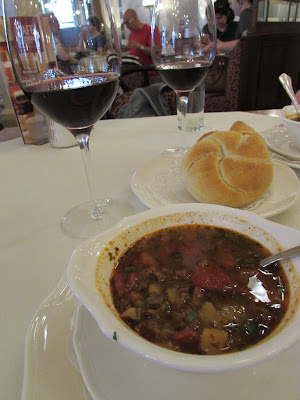The next morning we walked through the Natschmarkt before leaving the hotel to board the ship Adagio. Natschmarkt translates to "Nibble Market".
It was fun to see the different kinds of produce.
The long, wide square is lined with produce stalls, shops, and cafes. Vienna's top chefs shop here.
and bakery goods.
and things we didn't know what they were.
We were then transported over to the ship, which will be our home for the next 14 days.
After lunch on the ship, we headed back to Old Town and toured the very beautiful St. Charles church.
It is dedicated to Charles Borromeo, a 16th century bishop who saw Vienna through a 1713 epidemic. The twin spiral columns tell the story of Borromeo's life.
Inside the church the high altarpiece portrays the ascension of St. Charles.
The large round glass window high above the main altar with the Hebrew Tetragrammaton/Yahweh symbolizes God's omnipotence and through its warm yellow tone, God's love.
The inside of the dome is currently under renovation. We take an elevator and then climbed stairs to the top of the dome.
The dome's colorful 13,500-square-foot fresco, painted in the 1730's by Johann Michael Rottmayr, is undergoing renovation work.
We seem to be up in the clouds with the angels...
Back outside as we are admiring the church's exterior again...
...we come to the assistance of a group of young men wanting their photo taken.It is then back to the ship where we spend our first night on the Adagio.
We will have one more day to explore Vienna before we set sail on the Danube River for the next part of our voyage.
The next morning we went to the Opera House for a guided tour. We learned about the history of the company and the building.
As we waited in the front hall for our tour to begin, we posed in old costumes...
Terry looked like he would fit in the 19th century....
Me, not so much!
Nearly all of opera's greats have passed through here. Gustav Mahler and Richard Strauss served as musical directors. Luciano Pavarotti, Maria Callas, Placido Domingo have all sung from its stage.
Our 45-minute tour took us through the halls and even back stage where workers were preparing for the next performance.
After the tour we finished the city walk we had started earlier in the week. We walked over to the Hofburg Palace and watched carriage drivers in training with the famous white Lipizzaner stallions in front of the Spanish Riding School.
The statue below is of Habsburg Emperor Franz II (1768-1835), grandson of Empress Maria Theresa, father-in-law of Napoleon, and grandfather of the last great Habsburg emperor, Franz Josef, husband of Sisi.
Vienna's Imperial Palace, the Hofburg, was for centuries the seat of the Habsburgs, rulers of Austria until the end of World War I. A great deal of European history was written here, in particular by Empress Maria Theresa.
Today it is the official seat of the Austrian Head of State, the Federal President. The complex is particularly interesting as its major buildings reflect more than 700 years of architectural history; nearly every Austrian ruler since 1275 ordered additions or alterations.
As a result, the Hofburg shows many different architectural styles from Gothic to Renaissance, Baroque to Rococo. Together with its many squares and gardens, the Hofburg occupies an area of some 59 acres and is in many ways a "city-within-a-city" comprising 18 groups of buildings, 19 courtyards, and 2,600 rooms.
This is the Heldenplatz or Heroes' Square of the Hofburg Place. In the curved facade is the New Palace. Built in the early 1900s, this was to have been the new Habsburg living quarters. But in 1914, the heir to the throne, Archduke Franz Ferdinand was assassinated in Sarajevo. His death sparked World War I and the eventual end of 8 centuries of Habsburg rule.
Just a little more history....in this huge square in 1938, 300,000 Viennese gathered to welcome Adolf Hitler and celebrate their annexation with Germany. The Nazi tyrant stood on the balcony of the New Palace and declared, "Before the face of German history, I declare my former homeland now a part of the Third Reich. One of the pearls of the Third Reich will be Vienna." He never said "Austria", a word that was now forbidden.
Austria had once been a mighty empire of 50 million but after World War I Austria was a tiny, weak nation. Many Austrians willingly accepted Hitler's rule as Hitler promised a return to greatness.
Across the street from the Hofburg Palace stands a huge statue of perhaps the greatest of the Habsburgs...Maria Theresa. She was the only female Habsburg monarch and after her forty years of reign, Maria Theresa left a revitalized empire that influenced the rest of Europe throughout the 19th century.
The Parliament building, built from 1874 to 1883 in the Greek-Roman style. The architect created a total work of art; and as Greece is known as the cradle of democracy, the Parliament is designed like a temple.
And that's the statue Palas Athene in front of the building.
We finish our city walk and our time in Vienna by having a great lunch at Central Cafe.
To top off our meal, we ordered a delicious chocolate dessert.
Terry asked our waiter, "how do you pronounce it?" The waiter replied, "Warm chocolate cake". We wanted the German pronunciation!
That night we set sail on the Danube. We will cruise through Austria, Germany, and the Netherlands. To continue reading, scroll back up toward the top of this page and click in the right-hand column, the entry entitled: "Cruising through Austria to the Melk Abbey."



























































No comments:
Post a Comment